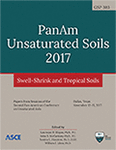Evaluating the Ability of Swell Prediction Models to Predict the Swell Behavior of Excessively High Plastic Soils
Publication: PanAm Unsaturated Soils 2017
Abstract
Lightly loaded structures underneath expansive soils encounter severe damage due to the swell/shrink nature of expansive soils resulting from moisture variations. Billions of dollars are spent every year to repair the damages caused by these soils in the U.S. and worldwide. Designing structures to accommodate the swelling strains is a major challenge as predicting the swelling potential of these soils accurately is not easy. A wide variety of swell prediction models have been introduced by various researchers to predict the behavior of these often-problematic expansive soils. These models include various properties of soils such as, plasticity characteristics, compaction conditions, consolidation characteristics, moisture content variations, matric suction, and clay mineralogical characteristics. However, these models are generally developed with typical moderate to high plastic soils in mind whose plasticity indices range from 25 to 45. Their applicability to soils that have liquid limits in the order of 200% is not well understood. In this paper, the ability of these models to predict the behavior of excessively high plastic soils with plasticity indices ranging from 45 to 85 were evaluated. For this purpose, four existing analytical prediction models that use combinations of above-mentioned properties were selected and used to predict the one-dimensional and three-dimensional swelling strains on three high swelling soils. These predictions were verified by conducting one-dimensional and three-dimensional swell tests on the three soil types. The swell tests were conducted at three different initial moisture contents to observe how well the models could predict different levels of moisture absorption. The ability of each of the four selected methods in predicting both 1D and 3D swell strains was discussed and their relative merits and demerits are highlighted. In addition, finite element modeling was performed to simulate one-dimensional and three-dimensional swell tests by using material models that use volumetric and suction changes with moisture contents to simulate expansive soil behavior within the finite element model. The results indicated that while the analytical prediction models gave reasonable results the finite element analysis predicted results were closest to the laboratory measure soils in case both 1D and 3D analyses. Among other analytical models the ones that incorporated mineralogical and suction data exhibited better results.
Get full access to this chapter
View all available purchase options and get full access to this chapter.
Information & Authors
Information
Published In
Copyright
© 2018 American Society of Civil Engineers.
History
Published online: Jun 20, 2018
Authors
Metrics & Citations
Metrics
Citations
Download citation
If you have the appropriate software installed, you can download article citation data to the citation manager of your choice. Simply select your manager software from the list below and click Download.
